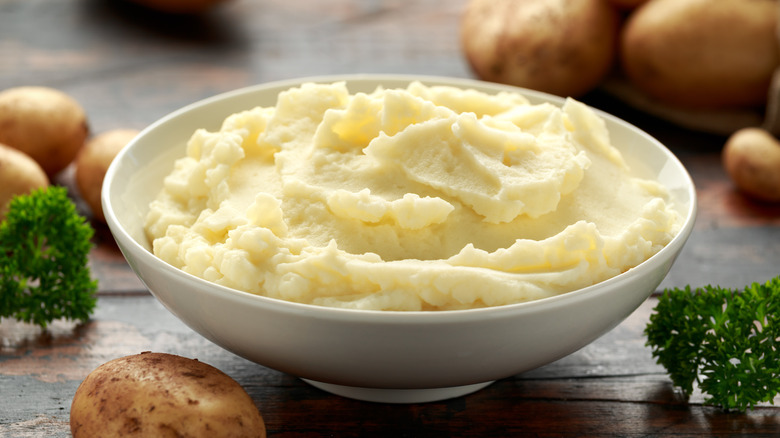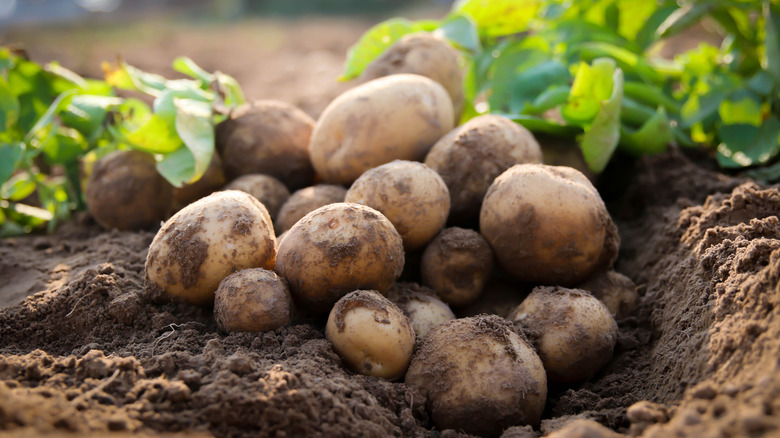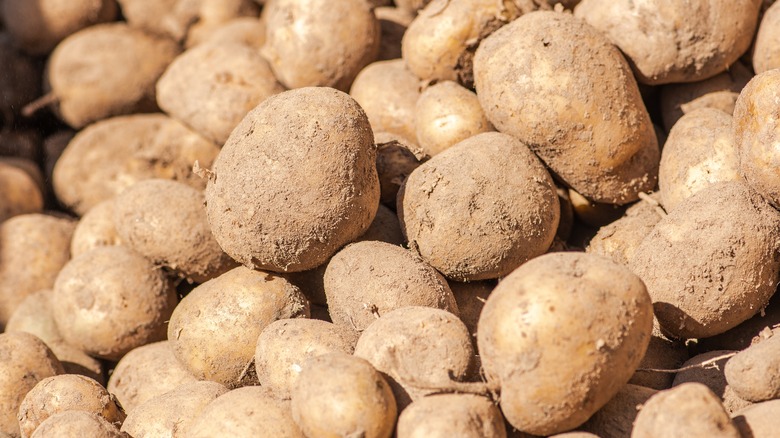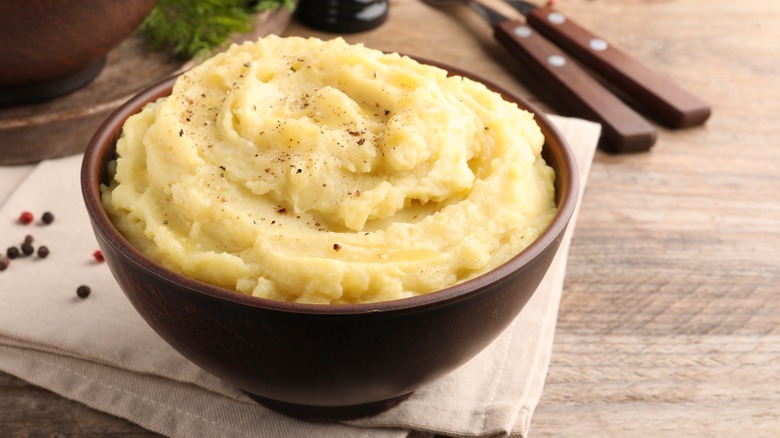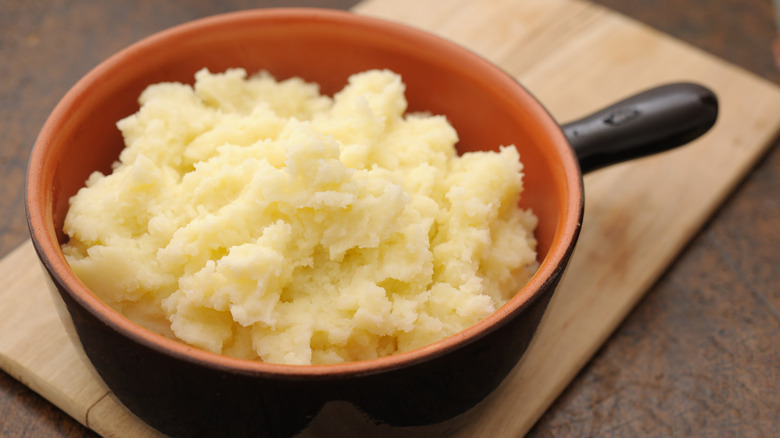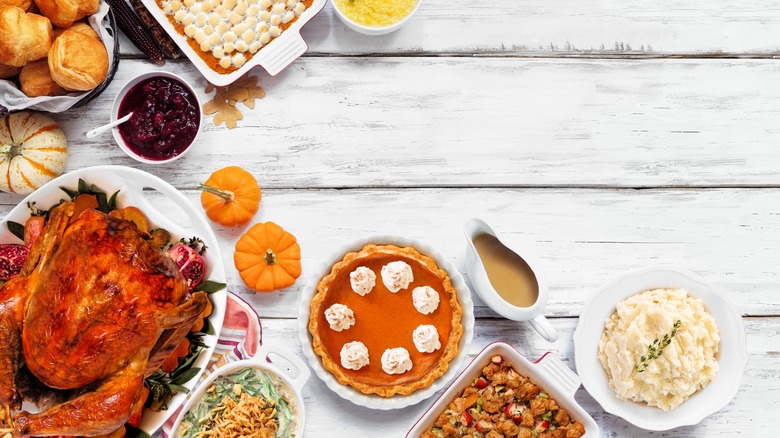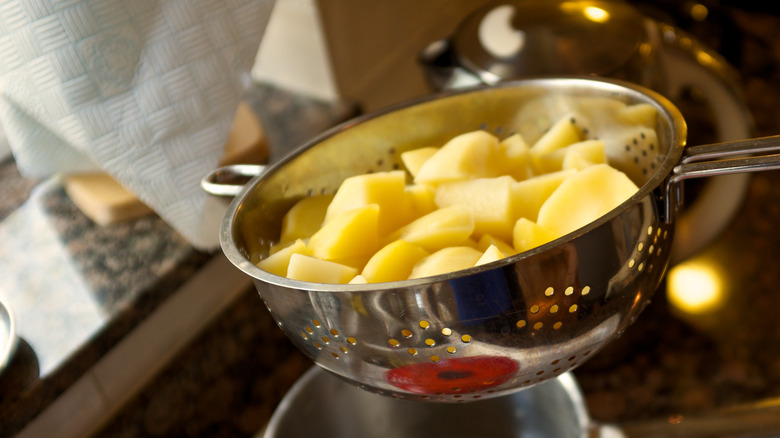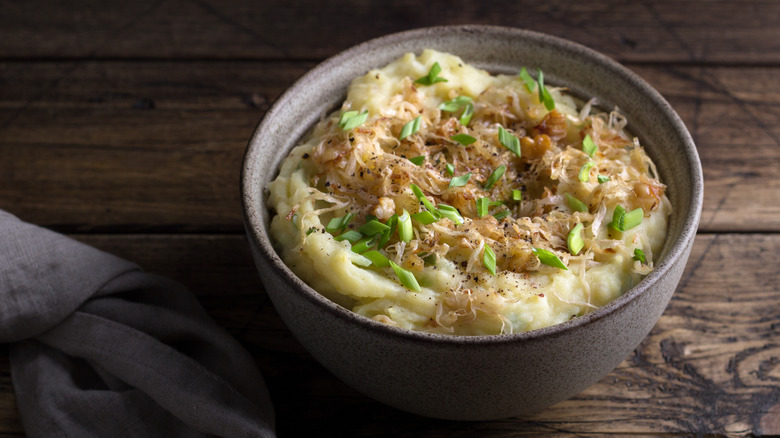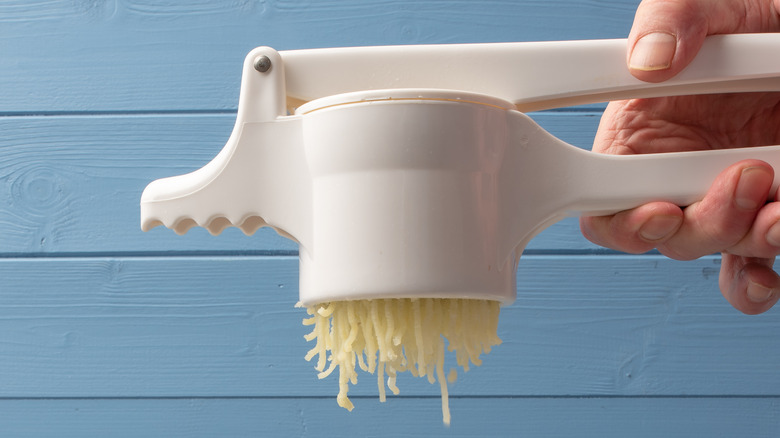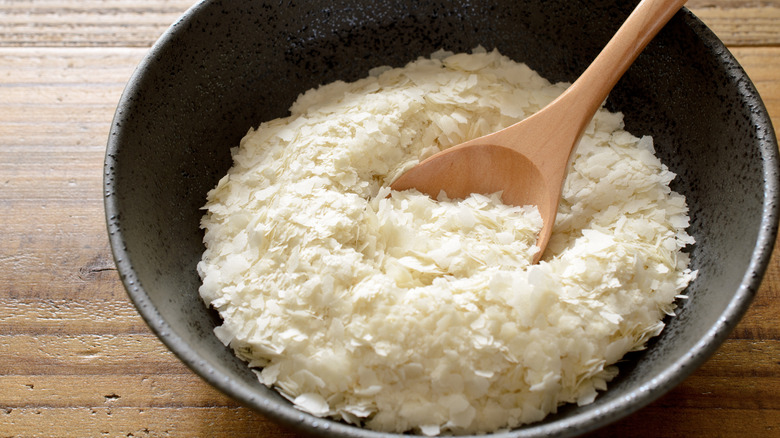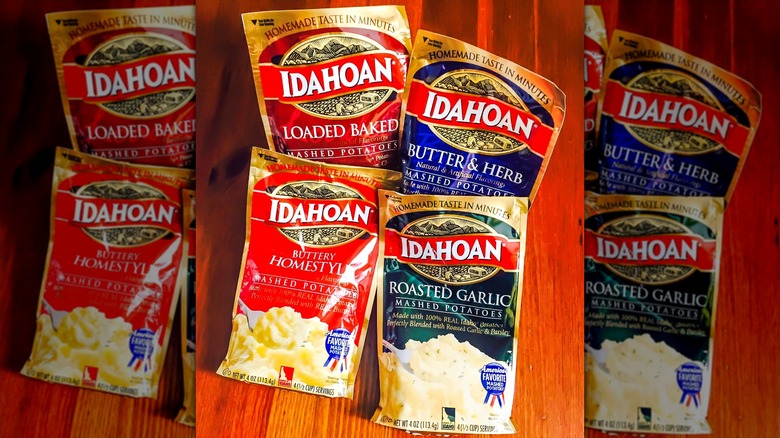What You Didn't Know About The History Of Mashed Potatoes
Mashed potatoes are a classic comfort food. There are a range of ways to make mashed potatoes, but all of them are delicious — you really can't go wrong with them. But, have you ever thought about the history of mashed potatoes? It seems like one of those basic dishes that has always existed. However, there's quite a long and convoluted backstory to this favorite. It took the stars aligning just right for mashed potatoes to even exist, and we sure are grateful for that.
It all started back in the Inca days in what's now known as Peru. If these folks hadn't started cultivating potatoes, we probably wouldn't have mash today. However, potatoes still had to make it to the other side of the world and back again, making it past people who thought humble spuds were only good as animal feed and caused leprosy in humans. There's a lot to unpack there, but we're interested in going deep into the origins of mashed potatoes.
Learning about how this dish came to be won't help you make restaurant-quality mashed potatoes, but it will leave you with some fun facts you can crack out at your next dinner party. Here's what you didn't know about the history of mashed potatoes.
Mashed potatoes might not exist if potatoes hadn't been cultivated in ancient Peru
The mashed potatoes you enjoy today wouldn't be possible without the cultivation of potatoes. This was done by the Indigenous people in what is now present-day Peru around 8,000 years ago. Wild potatoes grew in the South American Andes, near Lake Titicaca, but local farmers decided to cultivate them, thus starting us on our journey toward the investigation of mashed spuds. They were probably grown because they were easy to cultivate and calorie-dense, making them an ideal staple.
Without cultivated potatoes, it's unlikely that potatoes would be such a popular food. Wild potatoes are often small and many varieties aren't safe to eat. It's only the cultivation and selective breeding of large, tasty, and edible potatoes that allowed them to become such a worldwide phenomenon. That means we have a lot of reasons to thank the Indigenous people of the ancient Andes region.
Still, it took a long time for potatoes to take off. They were farmed for thousands of years before Spanish invaders brought an end to the Inca empire in the 1500s and brought potatoes home with them. However, they were used to days with around 12 hours of sunlight and 12 hours of darkness, so they didn't thrive when grown during Spanish summers with their long days. This means it took a little longer for potatoes to gain popularity in Europe — and for mashed potatoes — to be born.
Potatoes were once considered inedible and were even outlawed in some places
The initial reaction to potatoes in Europe was mixed and in many places, they were considered inedible. It might seem strange now, but people in Europe had never seen anything like potatoes, so it makes sense that they were skeptical at first. Not knowing the best cooking methods for potatoes or any handy potato hacks, initial results might not have been particularly tasty. Plus, as a member of the nightshade family, some made a connection between potatoes and witchcraft.
Things got particularly weird in France where potatoes were outlawed between 1748 and 1772. During these years, it was illegal to either grow or eat potatoes. For some reason, potatoes were rumored to spread disease — especially leprosy — which is what led to them being banned by the French. The fact that they grew underground was considered unusual. To the people of this time, it meant they were further from God and therefore lower in the hierarchy of foods. They were used to feed pigs and even the poorest members of society believed them to be unsuitable food for humans.
Today, potatoes might be considered among the tastiest foods out there — and it's not just mashed potatoes that earned them that title. However, there was a time when things were quite different. These much-beloved root veggies were thought to be the work of the devil and only fit to cause disease. How times have changed!
A man named Antoine-Augustin Parmentier helped popularize mashed potatoes
In the 1700s, a French military pharmacist named Antoine-Augustin Parmentier was captured by Prussian soldiers during the Seven Years' War and forced to eat nothing but potatoes. This was back when the French still believed that potatoes caused leprosy, so Parmentier was surprised not just that potatoes didn't give him any diseases, but that they were tasty and filling.
When he was released from captivity, Parmentier returned to his native France and began a campaign to show people how tasty, versatile, and — most importantly — safe-to-eat potatoes were. At this time, potatoes were still outlawed in France, but Parmentier had seen the light and wanted the ban on potatoes to be lifted. He started publicly demonstrating some of the ways to cook and prepare potatoes, including mashing them. So, this man was one of the earliest proponents of mashed potatoes in Europe. His campaign gained enough traction that the French government agreed to make growing and eating potatoes legal in 1772.
Now, we're not saying that it was a good thing that Parmentier was captured and imprisoned during the Seven Years' War. However, it did make a difference to French culinary tradition. Without him, it might have taken longer for mashed potatoes to gain popularity and we may not have other tasty French potato dishes, such as tartiflette or potato dauphinoise.
The first recipe for mashed potatoes appeared in a 1747 cookbook
Curious about the first known recipe for mashed potatoes? Let's delve into the history. The year is 1747, and the culinary world is about to be rocked by a revolutionary recipe. Enter Hannah Glasse, an English cookbook author who unveiled the first-ever recorded recipe for mashed potatoes. In her cookbook, "The Art of Cookery," Glasse gave readers the secrets to creating this humble yet heavenly dish. With simple instructions and accessible ingredients, she demystified the art of mashing potatoes to perfection. Glasse's book was known for being written in plain language, which is perhaps why it was one of the most popular cookbooks of its time.
In her recipe, 2 pounds of butter were mashed with a pint of milk, some salt, and a 1⁄4 pound of butter. Sounds delicious ... and fairly similar to the way people still make mashed potatoes today. Glasse was ahead of the game when it came to mashed potatoes. Writing a recipe in 1747 that's basically identical to one we'd make in 2024 and beyond is no mean feat. So, let's raise a spud to Hannah Glasse and think of her next time we try a new mashed potato recipe.
The founding fathers may have eaten mashed potatoes
The founding fathers of the United States might have been deeply flawed in some ways, but mashed potato lovers have one thing in common with them. Well, possibly, anyway. You see, Benjamin Franklin, Thomas Jefferson, and George Washington all owned copies of "The Art of Cookery" by Hannah Glasse. This is the book mentioned above that contained the first-ever recipe for mashed potatoes. As such, they might have ended up with mashed potatoes on their dinner plates.
Now, we're under no illusion about the fact that these founding fathers probably never set foot in a kitchen except to give orders. They all would have had kitchen staff and, in fact, all of them were slave owners, so we certainly don't want to sugarcoat things. These men were involved in a truly heinous part of history, even if they later played some role in the abolition of slavery. They weren't cooking up their own mashed potatoes and we don't know their opinions on this classic dish, but since they all had Glasse's seminal cookbook, maybe mashed potato was a staple in their households.
The first published American mashed potato recipe dates back to 1824
Now we know when the first-ever mashed potato recipe was published, but what about the first American mashed potato recipe? This came around 50 years later in an 1824 cookbook called "The Virginia Housewife" by Mary Randolph. This book was published by Randolph, a woman who had been born into a wealthy family but suffered a reversal of fortunes that meant she had to open a boarding house. Writing and releasing this cookbook was another way to make money from her domestic skills. However, it's also important to note that Randolph owned enslaved people whose knowledge and kitchen skills she would have drawn on to write this volume and who, of course, went unacknowledged at the time.
The recipe calls for boiling, draining, and drying potatoes before pushing them through a colander to mash them. An ounce of butter and a little milk is then added to the recipe, though far less milk than in Glasse's original recipe. It's interesting to see how mashed potatoes haven't changed all that much over the years. It's also notable that the colander is used a bit like a potato ricer. In the book, the recipe is mentioned as a good way to use up older potatoes. There are also a couple of mashed potato variations listed in this article, including mashed potatoes with onions and mashed potato balls, which are mixed with eggs and breadcrumbs and fried. We'd certainly try them!
Irish mashed potato has traditionally been made with kale or cabbage
There's an Irish version of mashed potatoes called colcannon and perhaps you're wondering what colcannon is and what it tastes like. It's quite a simple dish and is effectively mashed potato mixed with greens. These are often kale or cabbage, but you can use any greens. Traditionally speaking, people would have used whatever greens they had available to them. This can even include foraged greens, such as nettles or sorrel, as well as watercress, mustard greens, or even broccoli leaves. Modern colcannon recipes often also include green onions and may include fresh herbs for added flavor.
Ireland is known for its potato-heavy cuisine and people who live there also eat regular mashed potato, but the greens in colcannon are a welcome addition. You get the creamy richness you expect from mash but with the fresh flavor of the greens cutting through. And, the flavor profile changes depending on whether you use kale, cabbage, or other leafy greens. It makes a great side dish for all kinds of meals, and it's best made with starchy potatoes, as these give lighter, fluffier results. You should cook these potatoes thoroughly and let them steam dry before you mash them.
The first potato ricer was invented in 1887
There are many ways to mash a potato — with a basic potato masher, with a fork, or even with a mortar and pestle, which might have been used before potato mashers came about. But, many people agree that the lightest, fluffiest mashed potatoes come from a ricer, and this advent in mashed potato history came about in 1887.
This was the year when inventors Jacob Fitzgerald and William H. Silver were granted a patent for their groundbreaking creation: the "potato-masher and fruit-crusher." Little did they know, their invention would pave the way for a kitchen essential we now know as the potato ricer. This ingenious contraption is somewhat reminiscent of a garlic press. It works its magic by gently pressing the potato through a perforated body. The boiled potatoes come out in a mass of spaghetti-like strings that you can easily beat with milk and butter, giving you smooth potatoes that aren't gluey the way potatoes can get from over-mashing.
Fast forward to the present day, and the potato ricer remains a beloved kitchen gadget. It's known for its ability to effortlessly transform spuds into velvety smooth mash. Fitzgerald and Silver's patent may have been granted over a century ago, but their legacy lives on in every fluffy mound of mashed potatoes lovingly prepared with their revolutionary invention.
There was interest in instant mashed potatoes during WWII, but attempts weren't that successful
During the Second World War, there was a lot of interest in developing instant mashed potatoes as a solution to the logistical challenges of feeding troops in the field. The concept was simple but revolutionary: provide soldiers with a lightweight, shelf-stable alternative to traditional mashed potatoes that could be prepared with minimal time and resources.
In theory, instant mashed potatoes were an excellent idea — a convenient way to nourish soldiers on the go. However, the reality didn't quite match up with expectations. Despite earnest efforts, early attempts at producing instant mashed potatoes were less than satisfactory. One of the primary issues lay in achieving the desired texture and flavor. Part of what you want from mashed spuds is a creamy consistency and rice taste. However, the instant variety often fell short, resulting in a soggy mess rather than something weary soldiers would have been happy to eat for dinner.
Additionally, the preparation process for early instant mashed potatoes was far from ideal for the wartime setting. Some varieties took a long time to prepare, making them impractical for use in the field where time and resources were scarce. So, while instant mashed potatoes were used as rations in WWII, they were quite bad. They were known for being soggy and nothing much like real potatoes. Yes, they helped feed soldiers during the war effort, but they weren't worth eating.
Modern commercial instant mashed potatoes were perfected in the 1950s
During the mid-20th century, the culinary landscape was evolving at a rapid pace. With the rise of convenience foods and advancements in food processing technology, the stage was set for a revolution in mashed potato preparation. As we know, instant mashed potatoes existed during the era of WWII — but they were bad. It wasn't until around the late '40s and early '50s that they became more palatable.
The breakthrough came with the development of specialized processing techniques that allowed for the dehydration and reconstitution of mashed potatoes. By removing moisture from cooked potatoes and transforming them into a convenient powdered form, manufacturers unlocked a world of possibilities for quick and easy meal preparation.
In 1946, French's became licensed to produce instant mashed potatoes using some of these new and improved dehydration methods. And, in 1951, Idahoan — which is now perhaps the best-known manufacturer of instant mashed potatoes — was formed. The company was made up of a group of farmers who clubbed together to start a potato dehydration plant.
In the decades that followed, commercial instant mashed potatoes soared in popularity, becoming a staple in pantries and kitchens around the world. Their convenience and versatility made them a favorite in busy households. Are these potatoes perfect? No. But they're a heck of a lot better than what the soldiers in WWII had to put up with, so at least we can be thankful for that.
